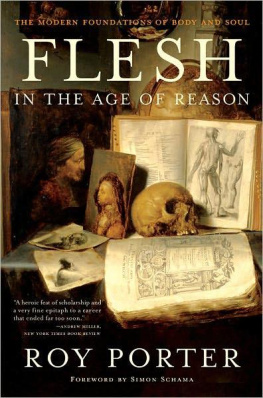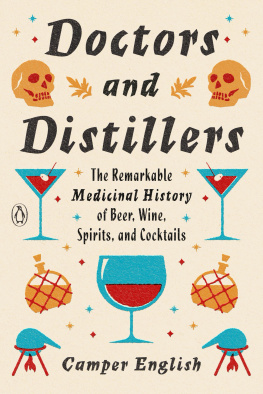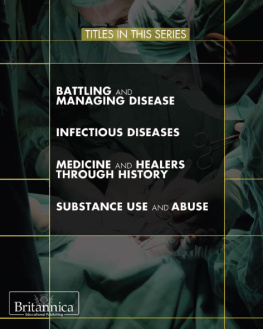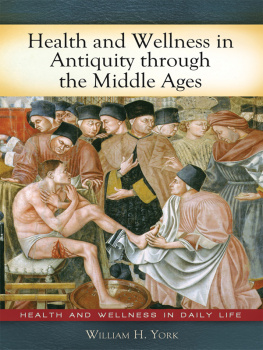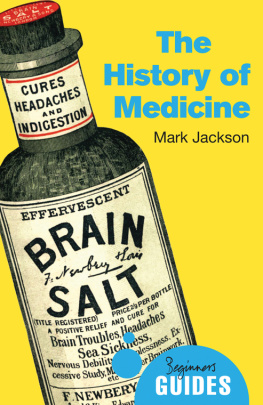
ROY PORTER
Blood and Guts
A SHORT HISTORY OF MEDICINE


First published in Great Britain 2002 by Allen Lane, an imprint of Penguin Books
Copyright 2002 by the Estate of Roy Porter
First published as a Norton paperback 2004
All rights reserved
Printed in the United States of America
For information about permission to reproduce selections from this book, write to Permissions, W. W. Norton & Company, Inc., 500 Fifth Avenue, New York, NY 10110
Manufacturing by The Haddon Craftsmen, Inc.
Production manager: Anna Oler
Library of Congress Cataloging-in-Publication Data
Porter, Roy, 1946Blood and guts : a short history of medicine / Roy Porter.1st American ed.
p. cm.
Includes bibliographical references and index.
ISBN 0-393-03762-2
1. MedicineHistoryPopular works. I. Title.
R131.P587 2003
ISBN 0-393-32569-5 pbk.
ISBN 978-0-393-24334-5 (e-book)
W. W. Norton & Company, Inc., 500 Fifth Avenue, New York, N.Y. 10110
www.wwnorton.com
W. W. Norton & Company Ltd., Castle House,
75/76 Wells Street, London W1T 3QT
Contents
Endpapers: Dance of Death, 1808. Coloured etching, I. Cruikshank.
Title page: A Drop of London Water, Punch cartoon, 1850.
1. Death Sitting on a Globe. Frontispiece from English Dance of Death, Thomas Rowlandson, 1816.
2. A physician dressed in protective plague costume. Line engraving, after Manget.
3. A monster representing the influenza virus. Pen and drink drawing, E. Noble, 1918.
4. Young suitor kneeling before death disguised as a young girl. A satire on syphilis.
5. A young Venetian woman, aged twenty-three, depicted before and after contracting cholera.
6. An over-indulgent man inflicted with the gout. The pain is represented by a demon burning his foot. Engraving, G. Cruikshank, 1818.
7. An African medicine man or shaman using symbols and small animals to eject a demon (disease). Wood engraving, after J. Leech.
8. Figure of Asklepios. Etching, N. Dorigny.
9. The Four Humours, fifteenth century.
10. Four heads of men who represent each of the four temperaments. Engraving, W. Johnson, early nineteenth century.
11. Surgeons participating in the amputation of a mans lower leg. Aquatint, Thomas Rowlandson, 1793.
12. Annals of a Winter Health Resort, Punch cartoon, 1850.
13. The Doctor. Luke Fildes, 1891.
14. A man with vegetables sprouting from all parts of his body as a result of taking J. Morisons Vegetable Pills. Lithograph, C. J. Grant, 1831.
15. A man being treated to a cascade of water in the name of hydrotherapy. Lithograph, C. Jacque, Paris, 1843.
16. Vesalius teaching anatomy. Andreas Vesalius, 1543.
17. Woodcut portrait of Vesalius. Andreas Vesalius, 1543.
18. Skeleton. Andreas Vesalius, 1543.
19. Two arms with blood vessels pronounced to indicate circulation. William Harvey, 1628.
20. Experiments on animal electricity using frogs legs. Galvani, 1791.
21. Diagram of the first wooden stethoscope. Laennec, 1819.
22. Pasteur in his laboratory among various pieces of scientific equipment.
23. Edward Jenner in the Smallpox and Inoculation Hospital. Etching, James Gillray, 1801.
24. Taking lymph from the calf to create vaccinations. C. Staniland, 1883.
25. Sufferers of syphilis being treated with mercury. John Sintelaer, 1709.
26. Chart showing cautery points on various parts of the body, 1462.
27. First-aid chart for barber surgeons showing how to treat wounded soldiers. Woodcut, sixteenth century.
28. An ill man being bled by his doctor. Etching, James Gillray, 1804.
29. The man-mid-wife. A full frontal picture divided in half, one side representing a man, the other a woman. Etching, I. Cruikshank, 1793.
30. A woman giving birth aided by a male surgeon, who fumbles beneath a sheet to save the woman from embarrassment. Wood engraving, 1711.
31. Ten diagrams showing various methods of delivering a baby using forceps. Etching, 1791.
32. Surgeons examining a mans chest using an X-ray without any protective clothing. W. Small, 1900.
33. A corpse is stuffed with newspapers after being raided for organs by two surgeons. Lithograph, N. Dorville, 1901.
34. Interior of a ward at the Middlesex hospital. Aquatint, J. Stadler, 1808.
35. At the Gates. The spectres of cholera, yellow fever and smallpox recoil in fear as their way is blocked by a barrier on which is written quarantine and by an angel holding a sword and shield on which is written cleanliness. 1885.
36. Appalling conditions of the hospital at Sebastopol during the Crimean War. Wood engraving, 1855.
37. Florence Nightingale in much improved conditions at the hospital in Scatari during the Crimean War. Lithograph, E. Walker, 1908.
38. Doctor and surgeon discussing a patient. Punch cartoon, 1925.
The author and publishers would like to express their thanks to the following sources of illustrative material and for permission to reproduce it: The Punch Library, title page, 13 and 38; The National Library of Medicine USA, 4, 19, 22, 23 and 35; The Bodleian Library, University of Oxford (MS Ashmole 1462, fol. 9v), 26; The British Library London, 27; Tate London, 2002, 12. All other images are courtesy of the Wellcome Library, London.
This book originated in lecture courses given for many years at the Wellcome Institute (reborn since October 2000 as The Wellcome Trust Centre for the History of Medicine at University College London), and some of it was written there before my retirement in September 2001. For making this book possible, I wish to acknowledge the enormous support given to me over the years by many members of the Institutes staff, notably my secretaries Frieda Houser and later Rebecca Baker and Emma Ford, and the administrator Alan Shiel. My gratitude to Alan and to the Director, Hal Cook, for making such a generous contribution to the cost of the illustrations. Not least, thanks to all the students who made my twenty years at the Institute such a pleasure and whose critical responses helped me develop my ideas. I hope future students will find this book as stimulating as I found those I taught.
Drafts have been read by Hal Cook and Natsu Hattori, to whom I am deeply grateful for their customarily candid criticism and shrewd suggestions. Retyping of numerous versions has been done by Laurent Busy, Caroline Coulter, Debra Scallan and the indefatigable Sheila Lawler. Thanks also to Jed Lawler for coming yet again to the rescue of a computer buffoon.
The enthusiasm of Simon Winder at Penguin has, as always, been a delight. Bela Cunha proved an excellent copy-editor and Jane Henderson compiled the index with her usual acumen.
The art has three factors, the disease, the patient, the physician. The physician is the servant of the art. The patient must cooperate with the physician in combating the disease.
Hippocrates, Epidemics, I, 11
Physician, heal thyself.
St Luke, 4: 23
This survey explores the historical interaction of people, disease and health care, set in context of societies and their beliefs. Brevity compels me to narrow my focus to Western medicine unique in being the only tradition which has succeeded in globalizing itself. Emphasizing change over continuity, I tell my story with as much narrative detail as space allows: disease (Chapter 1); healers in their various incarnations (Chapter 2); the investigation of the body (Chapter 3); the modern biomedical sciences pioneered in the laboratory and the consequent biomedical model of disease (Chapter 4); therapeutics, especially in the scientific age (Chapter 5); surgery (Chapter 6); and that key medical institution, the hospital (Chapter 7). The concluding discussion (Chapter 8) assesses the wider socio-political aspects and implications of modern medicine.
Next page

